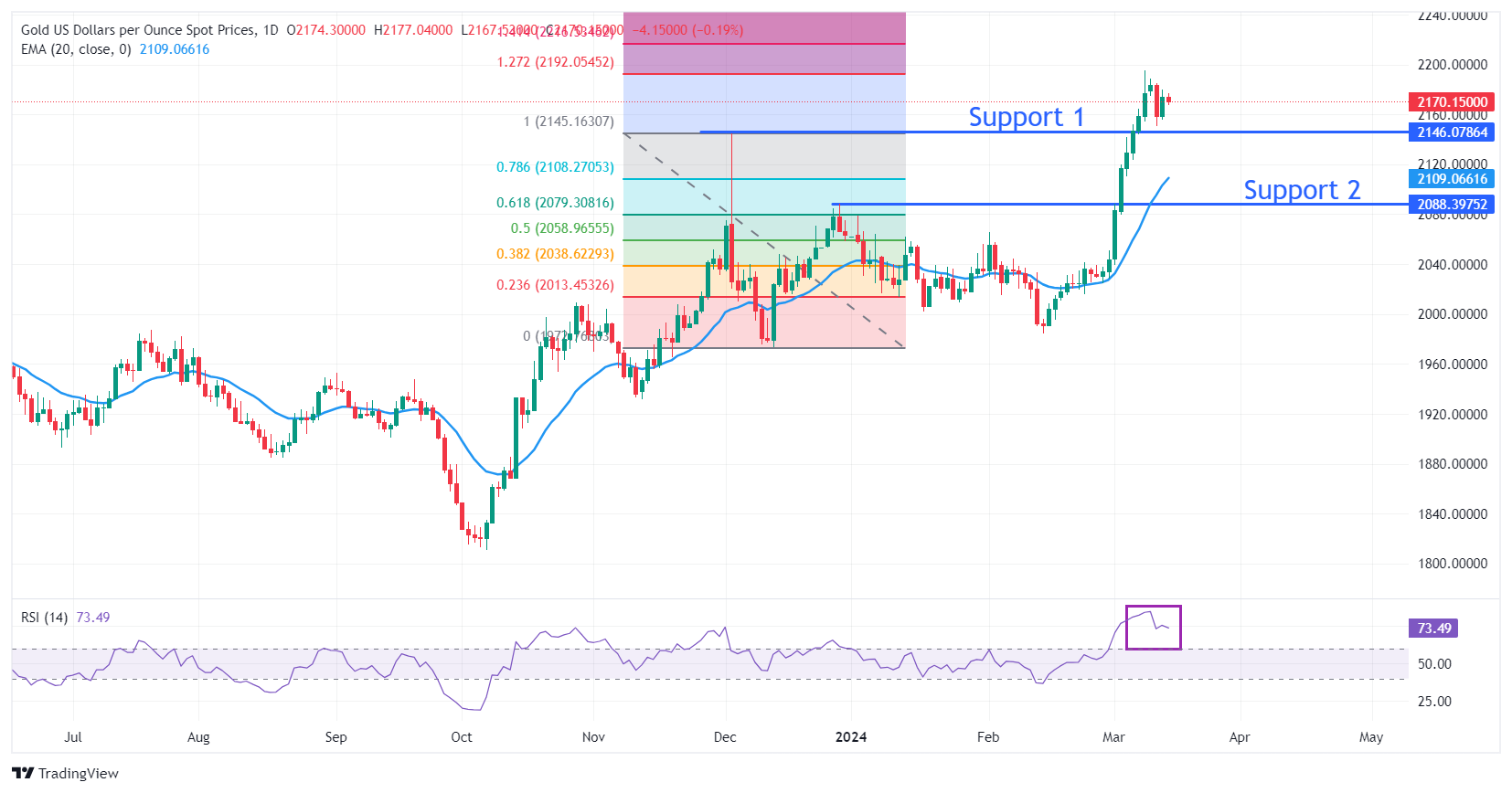- The price of Gold falls after the bad US PPI data for February.
- US retail sales grew 0.6%, missing expectations.
- Rising US bond yields weigh on gold price.
The price of Gold (XAU/USD) falls sharply in the early Thursday session in New York, as the United States Bureau of Labor Statistics (BLS) has reported a warmer than expected Producer Price Index (PPI). expected for February. The precious metal has come under pressure from the firmness of the US Dollar (USD) and bond yields, on expectations that PPI data will make the inflation outlook persistent. The US Census Bureau has reported that retail sales grew more slowly than the market expected.
US February inflation data, released on Tuesday, exceeded expectations. Now, a similar trend in PPI data is expected to increase uncertainty over the Federal Reserve's (Fed) rate cut expectations for the June policy meeting. This has caused 10-year US Treasury yields to rise to 4.21%, increasing the opportunity cost of holding unprofitable assets like Gold.
The US Dollar Index (DXY) has risen slightly to 102.85 points. Looking ahead, the main trigger for these assets will be the Fed's interest rate decision and the new dot chart, which offers projections on interest rates. The last dot chart, released at the December meeting, indicated three rate cuts this year.
Daily summary of market movements: Gold price falls on rising US yields
- The price of Gold falls to $2,160, pressured by the rise in US bond yields and the firmness of the Dollar, following the poor US PPI data for February.
- The annual core PPI, which strips out volatile food and energy prices, grew at a steady 2.0%, versus expectations of 1.9%. The monthly core inflation figure rose at a higher pace of 0.3%, compared to expectations of 0.2%, but remained below the previous reading of 0.5%.
- The monthly headline PPI grew strongly, 0.6%, compared to expectations and the previous reading of 0.3%. The annual headline PPI accelerated to 1.6%, compared to the consensus of 1.1% and the January reading of 1.0%%. PPI data shows the pace at which producers have raised or lowered factory gate prices for goods and services.
- Meanwhile, the US Census Bureau has reported that monthly retail sales data grew moderately by 0.6% in February, compared to expectations of 0.8%. In January, retail sales data contracted significantly by 1.1%. Investors closely monitor retail sales data to monitor household spending, one of the main drivers of growth in the US economy.
Technical analysis: Gold price falls to $2,160

The price of Gold oscillates within Tuesday's trading range between $2,154 and $2,180. The precious metal is slowly entering a non-directional trend where volatility contracts sharply. Previously, the yellow metal fell after marking a new all-time high near $2,195, which coincides with the 1.27% Fibonacci extension level (traced from the December 4 high near $2,145 to the December 13 low at $1,973.3).
On the downside, the December 4 high near $2,145 and the December 28 high at $2,088 will act as major support levels.
The Relative Strength Index (RSI) 14 retreats from its high near 84.50, although bullish momentum remains active.
Pound Sterling FAQ
What is the Pound Sterling?
The British Pound (GBP) is the oldest currency in the world (886 AD) and the official currency of the United Kingdom. It is the fourth most traded currency unit in the world, with 12% of all transactions and an average of $630 billion per day, according to 2022 data.
Its key currency pairs are GBP/USD, also known as “Cable”, which represents 11% of the forex market, GBP/JPY, or the “Dragon” as it is known to traders (3%), and EUR/GBP (2%). The pound sterling is issued by the Bank of England (BoE).
How do Bank of England decisions influence the Pound Sterling?
The most important factor influencing the value of the Pound Sterling is the monetary policy decided by the Bank of England. The Bank of England bases its decisions on achieving its main objective of “price stability”, that is, a stable inflation rate of around 2%. Its main tool to achieve this is the adjustment of interest rates.
When inflation is too high, the Bank of England tries to contain it by raising interest rates, which makes access to credit more expensive for individuals and companies. This tends to be positive for the GBP, as higher interest rates make the UK a more attractive place for global investors to park their money.
When inflation is too low, it is a sign that economic growth is slowing. In this scenario, the BoE will consider lowering interest rates to make credit cheaper, so that companies borrow more to invest in projects that generate growth.
How does economic data influence the value of the Pound?
The published data gauges the health of the economy and may influence the value of the Pound sterling. Indicators such as GDP, manufacturing and services PMIs, and employment can influence the direction of the Pound.
A strong economy is good for the British pound. Not only does it attract more foreign investment, but it may encourage the Bank of England to raise interest rates, which will directly strengthen the Pound. Otherwise, if economic data is weak, the pound is likely to fall.
How does the trade balance affect the Pound?
Another significant data for the pound sterling is the trade balance. This indicator measures the difference between what a country earns from its exports and what it spends on imports during a given period.
If a country produces highly sought-after exports, its currency will benefit exclusively from the additional demand created by foreign buyers wishing to purchase these goods. Therefore, a positive net trade balance strengthens a currency and vice versa for a negative balance.
Source: Fx Street
I am Joshua Winder, a senior-level journalist and editor at World Stock Market. I specialize in covering news related to the stock market and economic trends. With more than 8 years of experience in this field, I have become an expert in financial reporting.







